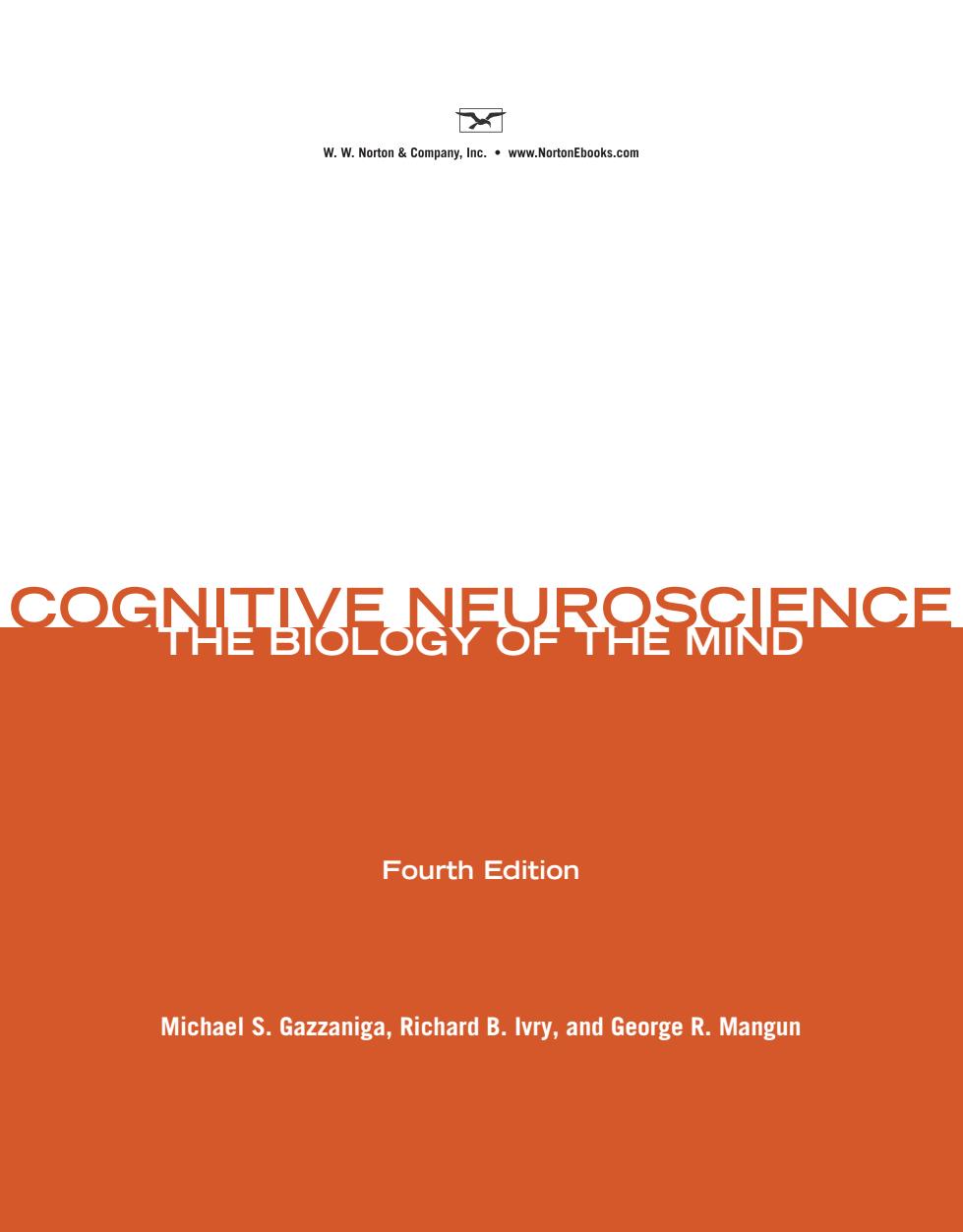
G W.W.Norton&Company,Inc.www.NortonEbooks.com COGNT%8RR后NCE Fourth Edition Michael S.Gazzaniga,Richard B.Ivry,and George R.Mangun
COGNITIVE NEUROSCIENCE Michael S. Gazzaniga, Richard B. Ivry, and George R. Mangun THE BIOLOGY OF THE MIND Fourth Edition
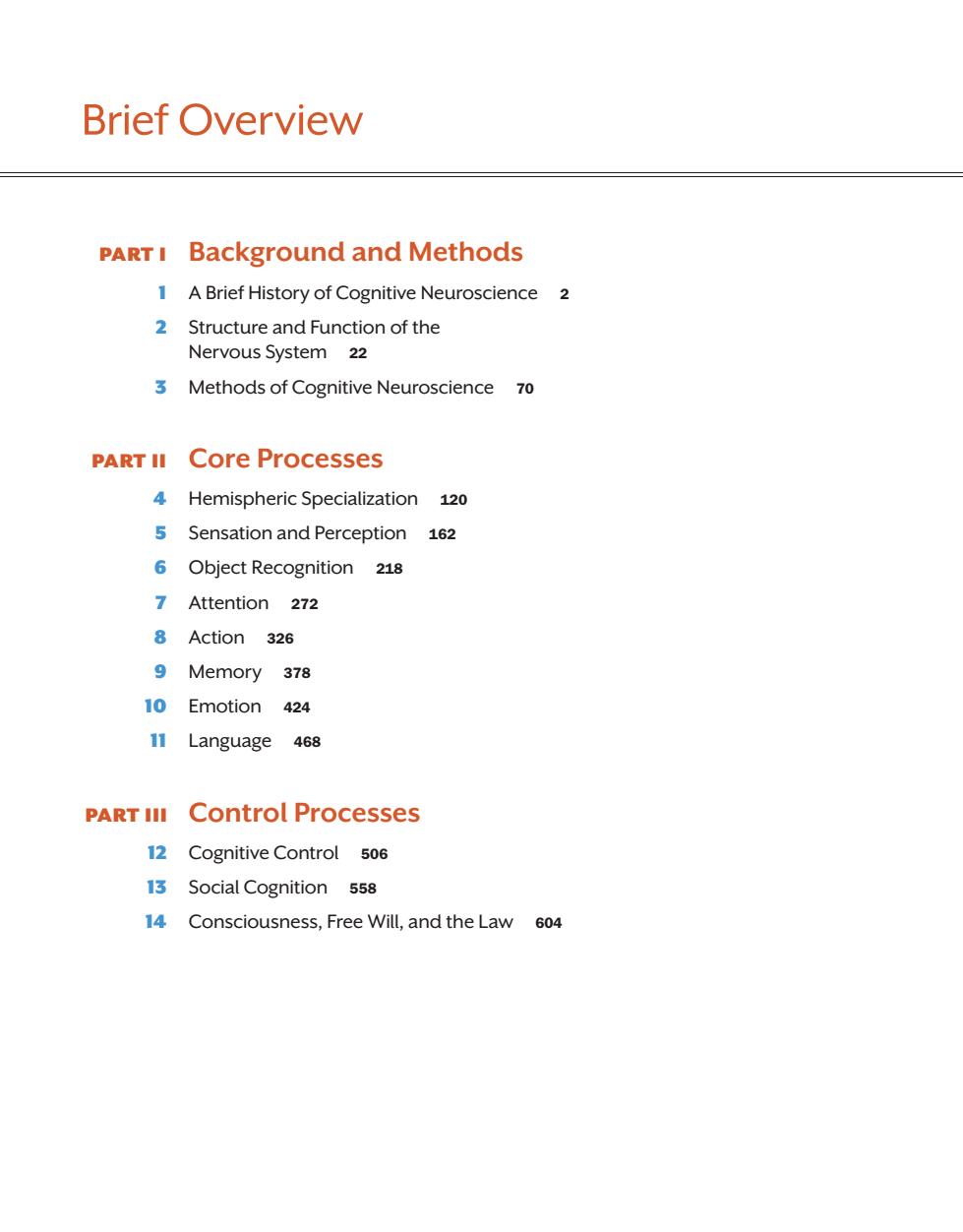
Brief Overview PARTI Background and Methods 1 A Brief History of Cognitive Neuroscience 2 2 Structure and Function of the Nervous System 22 3 Methods of Cognitive Neuroscience 70 PARTII Core Processes 4 Hemispheric Specialization 120 5 Sensation and Perception 162 6 Object Recognition 218 7 Attention 272 8 Action 326 9 Memory 378 10 Emotion 424 11 Language 468 PARTI Control Processes 12 Cognitive Control 506 13 Social Cognition 558 14 Consciousness,Free Will,and the Law 604
PART I Background and Methods 1 A Brief History of Cognitive Neuroscience 2 2 Structure and Function of the Nervous System 22 3 Methods of Cognitive Neuroscience 70 PART II Core Processes 4 Hemispheric Specialization 120 5 Sensation and Perception 162 6 Object Recognition 218 7 Attention 272 8 Action 326 9 Memory 378 10 Emotion 424 11 Language 468 PART III Control Processes 12 Cognitive Control 506 13 Social Cognition 558 14 Consciousness, Free Will, and the Law 604 Brief Overview 00i_xviii_Cogneu_4e_FM.indd iv 8/1/13 1:22 PM
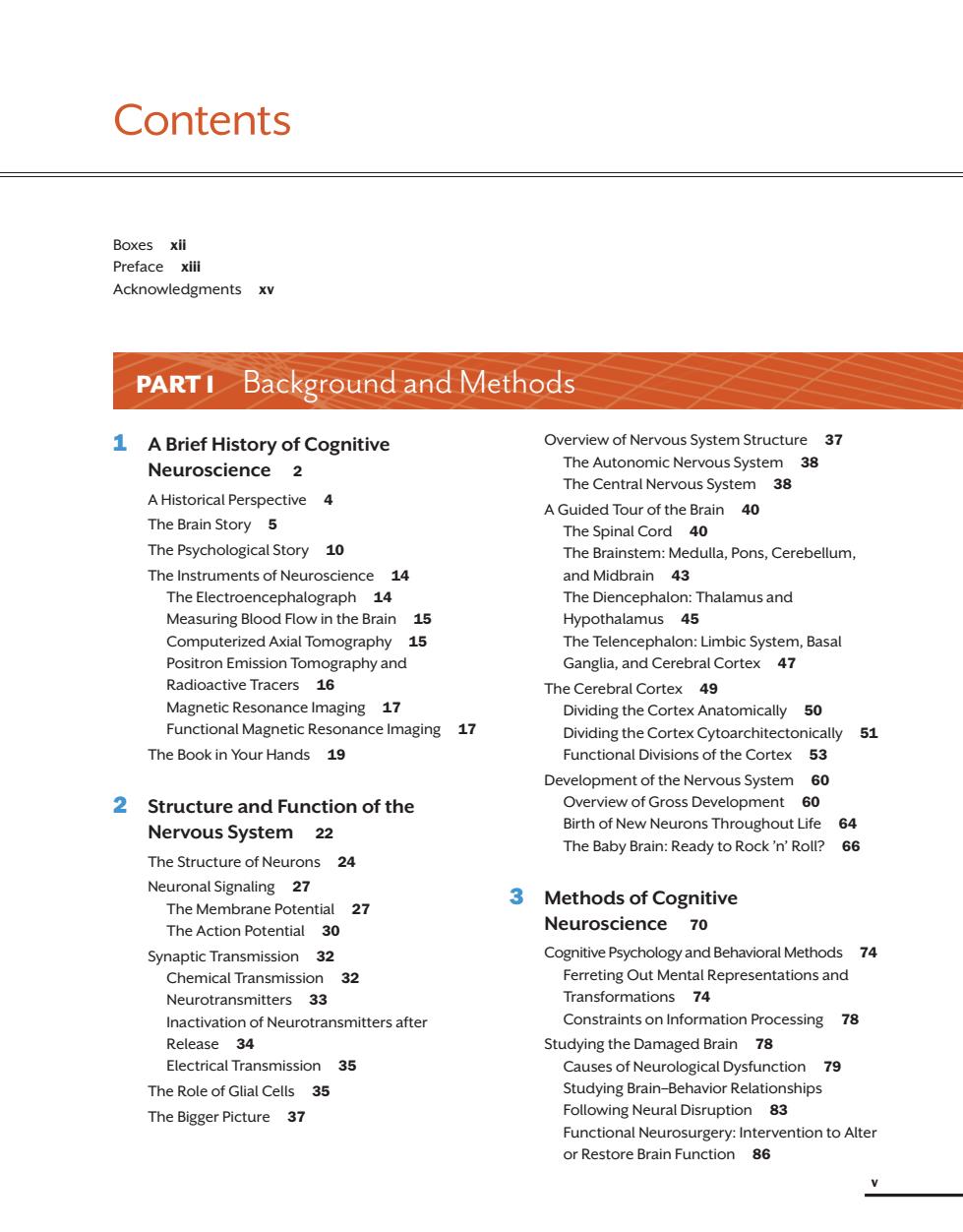
Contents ace Acknowledgments xv PARTI Background and Methods 1 A Brief History of Cognitive Overview of Nervous System Structure 37 Neuroscience 2 The Autonomic Nervous System 38 The Central Nervous System 38 AHistorical Perspective 4 40 The Brain Story 5 The Psychological Story 10 The Brainstem:M edulla,Pons,Cerebellum The Instruments of Neuroscience 14 and Midbrain 43 The Electroencephalograph 14 The Diencephalon:Thalamus and Measuring Blood Flow in the Brain 15 Hypothalamus 45 Computerized Axial Tomography 15 The Telencephalon:Limbic System.Basal Positron Emission Tomography and Ganglia,and Cerebral Cortex 47 Radioactive Tracers 16 The Cerebral Cortex 49 Magnetic Rea maging Dividing the Cortex Anatomically 50 Functional Magnetic Resonance Imaging 17 Dividing the Cortex Cytoarchitectonically 51 The Book in Your Hands 19 Functional Divisions of the Cortex 53 Development of the Nervous System 60 2 Structure and Function of the Overvie oss Developmen Nervous System 22 w Neurons Throughout Lit 64 The Baby Brain:Ready to Rock'n'Roll? 66 The Structure of Neurons 24 Neuronal Signaling 27 3 The Membrane Potential 27 Methods of Cognitive The Action Potential 30 Neuroscience 70 Synaptic Transmission 32 Cognitive Psychology and Behavioral Methods 74 Chemical Tran 32 Ferreting Out Mental Representations and rotrans 33 Transformations 74 Constraints on Information Processing 78 Release Studying the Damaged Brain 78 Electrical Transmission 35 Causes of Neurological Dysfunction 79 The Role of Glial Cells 35 Studying Brain-Behavior Relationships The Bigger Picture 37 Following Neural Disruption 83 Functional Neurosurgery:Intervention to Alter or Restore Brain Function 86
Contents Boxes xii Preface xiii Acknowledgments xv 1 A Brief History of Cognitive Neuroscience 2 A Historical Perspective 4 The Brain Story 5 The Psychological Story 10 The Instruments of Neuroscience 14 The Electroencephalograph 14 Measuring Blood Flow in the Brain 15 Computerized Axial Tomography 15 Positron Emission Tomography and Radioactive Tracers 16 Magnetic Resonance Imaging 17 Functional Magnetic Resonance Imaging 17 The Book in Your Hands 19 2 Structure and Function of the Nervous System 22 The Structure of Neurons 24 Neuronal Signaling 27 The Membrane Potential 27 The Action Potential 30 Synaptic Transmission 32 Chemical Transmission 32 Neurotransmitters 33 Inactivation of Neurotransmitters after Release 34 Electrical Transmission 35 The Role of Glial Cells 35 The Bigger Picture 37 Overview of Nervous System Structure 37 The Autonomic Nervous System 38 The Central Nervous System 38 A Guided Tour of the Brain 40 The Spinal Cord 40 The Brainstem: Medulla, Pons, Cerebellum, and Midbrain 43 The Diencephalon: Thalamus and Hypothalamus 45 The Telencephalon: Limbic System, Basal Ganglia, and Cerebral Cortex 47 The Cerebral Cortex 49 Dividing the Cortex Anatomically 50 Dividing the Cortex Cytoarchitectonically 51 Functional Divisions of the Cortex 53 Development of the Nervous System 60 Overview of Gross Development 60 Birth of New Neurons Throughout Life 64 The Baby Brain: Ready to Rock ’n’ Roll? 66 3 Methods of Cognitive Neuroscience 70 Cognitive Psychology and Behavioral Methods 74 Ferreting Out Mental Representations and Transformations 74 Constraints on Information Processing 78 Studying the Damaged Brain 78 Causes of Neurological Dysfunction 79 Studying Brain–Behavior Relationships Following Neural Disruption 83 Functional Neurosurgery: Intervention to Alter or Restore Brain Function 86 PART I Background and Methods v 00i_xviii_Cogneu_4e_FM.indd v 8/1/13 1:22 PM
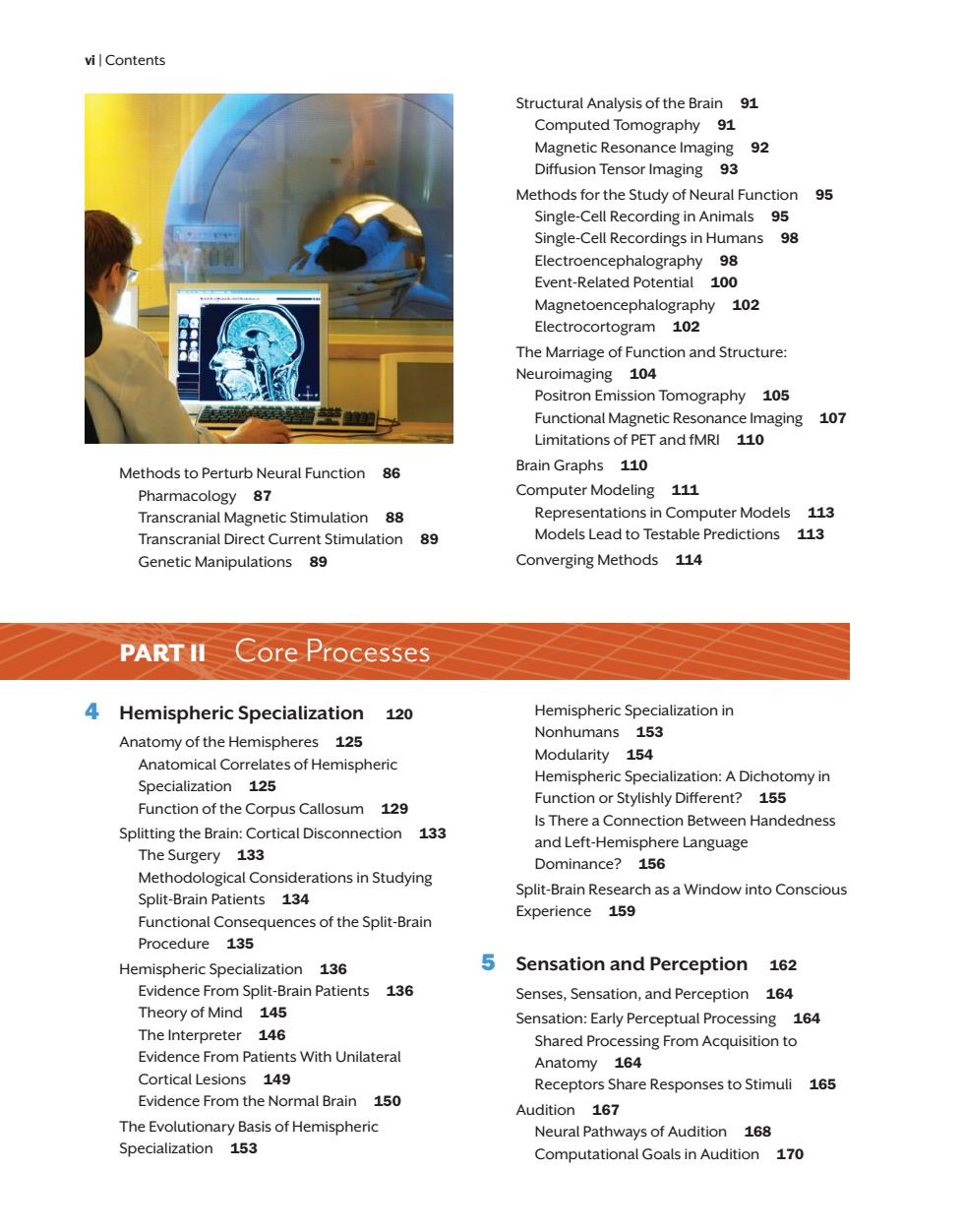
vi Contents Structural Analysis of the Brain 91 Computed Tomography 91 Magnetic Resonance Imaging 92 Diffusion Tensor Imaging 93 Methods for the Study of Neural Function 95 Single-Cell Recording in Animals 95 Single-Cell Recordings in Humans 98 Electroencephalography 98 Event-Related Potential 100 Magnetoencephalography 102 trocortogram 102 The Marriage of Function and Structure: Neuroimaging 104 Positron Emission Tomography 105 Functional Magnetic Resonance Imaging 107 Limitations of PET and fMRI 110 Methods to Perturb Neural Function 86 Brain Graphs 110 Pharmacol Computer Modeling 111 lagnetic Stimulation 88 Representations in Computer Models 113 anscranial Direct Current Stimulation 89 Models Lead to Testable Predictions 113 Genetic Manipulations 89 Converging Methods 114 PART II Core Processes 4 Hemispheric Specialization 120 Hemispheric Specialization in Anatomy of the Hemispheres 125 Nonhumans 153 Modularity 154 Anatomical Correlates of Hemispheric Hemi Specialization 125 ialization:A Dichotomy in Function of the Corpus Callosum 129 Function or Styishly Different?55 re a Connection Between Handedness Splitting the Brain:Cortical Disconnection 133 The Surgery 133 and Left-He Methodological Considerations in Studying Dominance? Split-Brain Patients 134 Split-Brain Research as a Window into Conscious Experience 159 Functional Consequences of the split-Brain Procedure 135 Hemispheric Specialization 136 5 Sensation and Perception 162 Evidence From Split-Brain Patients 136 Senses,Sensation,and Perception 164 Theory of Mind 145 Sensation:Early Perceptual Processing 164 The Interpreter 146 Shared Proc ing From Acquisition to Evidence From Patients With Unilateral Cortical Lesions 149 Anatomy 164 Receptors Share Responses to Stimuli 165 Evidence From the Normal Brain 150 Audition 167 The Evolutionary Basis of Hemispheric Neural Pathways of Audition 168 Specialization 153 Computation Goals in Audition 10
vi | Contents 4 Hemispheric Specialization 120 Anatomy of the Hemispheres 125 Anatomical Correlates of Hemispheric Specialization 125 Function of the Corpus Callosum 129 Splitting the Brain: Cortical Disconnection 133 The Surgery 133 Methodological Considerations in Studying Split-Brain Patients 134 Functional Consequences of the Split-Brain Procedure 135 Hemispheric Specialization 136 Evidence From Split-Brain Patients 136 Theory of Mind 145 The Interpreter 146 Evidence From Patients With Unilateral Cortical Lesions 149 Evidence From the Normal Brain 150 The Evolutionary Basis of Hemispheric Specialization 153 Hemispheric Specialization in Nonhumans 153 Modularity 154 Hemispheric Specialization: A Dichotomy in Function or Stylishly Different? 155 Is There a Connection Between Handedness and Left-Hemisphere Language Dominance? 156 Split-Brain Research as a Window into Conscious Experience 159 5 Sensation and Perception 162 Senses, Sensation, and Perception 164 Sensation: Early Perceptual Processing 164 Shared Processing From Acquisition to Anatomy 164 Receptors Share Responses to Stimuli 165 Audition 167 Neural Pathways of Audition 168 Computational Goals in Audition 170 PART II Core Processes Structural Analysis of the Brain 91 Computed Tomography 91 Magnetic Resonance Imaging 92 Diffusion Tensor Imaging 93 Methods for the Study of Neural Function 95 Single-Cell Recording in Animals 95 Single-Cell Recordings in Humans 98 Electroencephalography 98 Event-Related Potential 100 Magnetoencephalography 102 Electrocortogram 102 The Marriage of Function and Structure: Neuroimaging 104 Positron Emission Tomography 105 Functional Magnetic Resonance Imaging 107 Limitations of PET and fMRI 110 Brain Graphs 110 Computer Modeling 111 Representations in Computer Models 113 Models Lead to Testable Predictions 113 Converging Methods 114 Methods to Perturb Neural Function 86 Pharmacology 87 Transcranial Magnetic Stimulation 88 Transcranial Direct Current Stimulation 89 Genetic Manipulations 89 00i_xviii_Cogneu_4e_FM.indd vi 8/1/13 1:22 PM
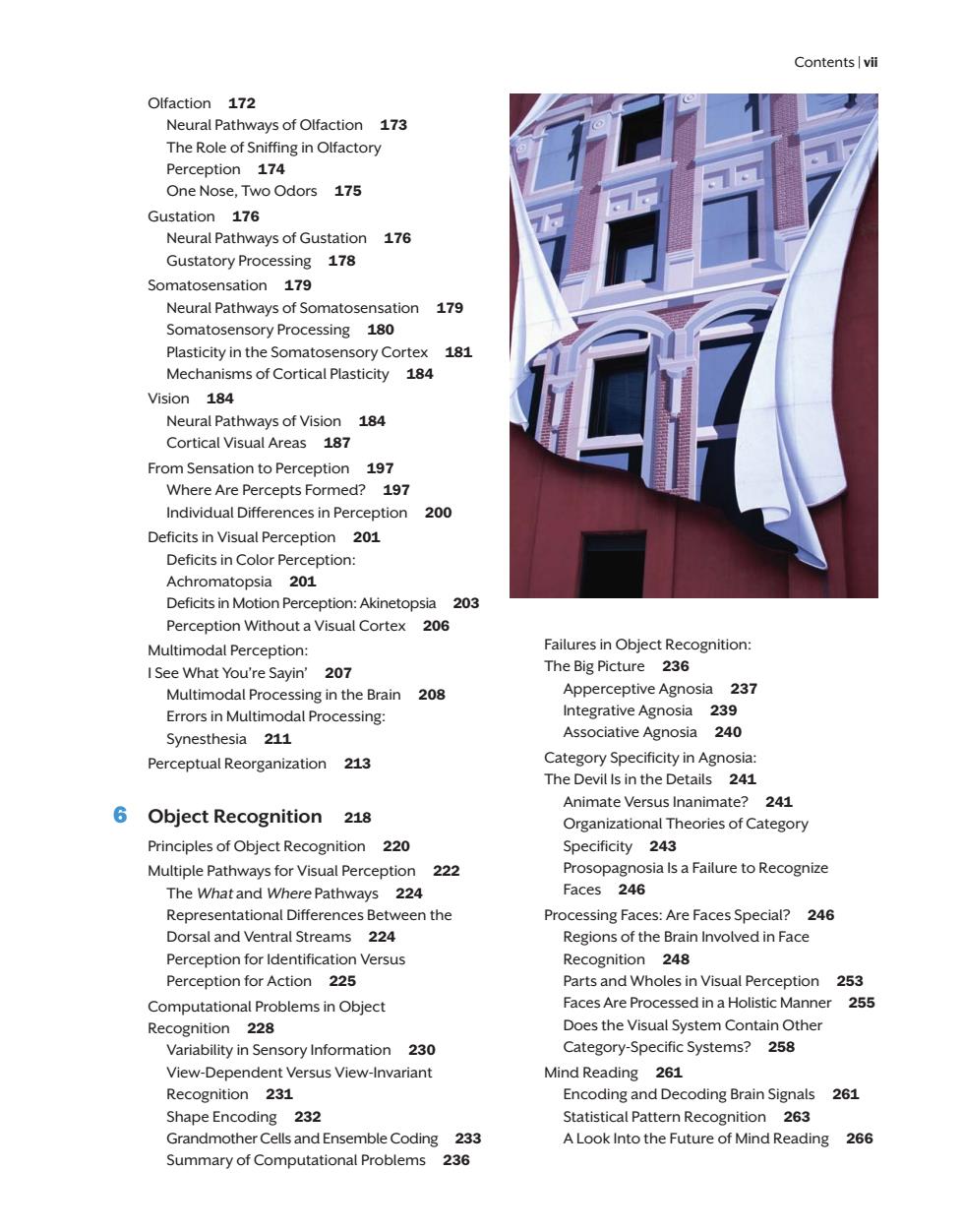
Contents|vii Olfaction 172 Neural Pathways of Olfaction 173 The Role of Sniffing in Olfactory Perception 174 One Nose,Two Odors 175 176 vays of Gustation 176 Gustatory Processing 178 Somatosensation 179 Neural Pathways of Somatosensation 179 Somatosensory Pro sing 180 nsory Corte 181 184 Vision 184 Neural Pathways of Vision 184 Cortical Visual Areas 187 From Sensation to Perception 197 Where Are Percepts Formed? 197 Individual Differences in Perception 200 Deficits in Visual Perception 201 Deficits in Color Pere ption: sia 203 Perception Without a Visual Cortex 206 Multimodal Perception: Failures in Object Recognition I See what You're Savin'207 The Big Picture 236 Multimodal Processing in the Brain 208 Apperceptive Agnosia 23 Errors in multimodal p Integrative Agnosia 23 Synesthesia 211 Associative Agnosia 240 Perceptual Reorganization 213 241 6 Object Recognition 218 241 heories of Category Principles of Object Recognition 220 Specificity 243 Multiple Pathways for Visual Perception 222 Prosopagnosia ls a Failure to Recognize The Whatand Where Pathways 224 Faces 246 entational Diffe n the Dorsal and Ven tral st 224 Regions d in Face Perception for ldentificati nVersus Recognitic Perception for Action 25 Parts and Wholes in Visual Perc tior Computational Problems in Object Faces Are Processed in a Holistic Manne Recognition 228 Does the Visual System Contain Other Variability in Sensory Information 230 Categorv-Specific Systems?258 View-De ndent Versus View-Invari Mind Reading 261 Recognition 231 Encoding and De coding Brain Sig 261 Shape Encoding 232 tatisti l Pattern Re <63 Grandmother Cells and Ensemble Coding 233 A Look Into the Future of Mind Reading 266 Summary of Computational Problems 236
Contents | vii Olfaction 172 Neural Pathways of Olfaction 173 The Role of Sniffi ng in Olfactory Perception 174 One Nose, Two Odors 175 Gustation 176 Neural Pathways of Gustation 176 Gustatory Processing 178 Somatosensation 179 Neural Pathways of Somatosensation 179 Somatosensory Processing 180 Plasticity in the Somatosensory Cortex 181 Mechanisms of Cortical Plasticity 184 Vision 184 Neural Pathways of Vision 184 Cortical Visual Areas 187 From Sensation to Perception 197 Where Are Percepts Formed? 197 Individual Differences in Perception 200 Defi cits in Visual Perception 201 Defi cits in Color Perception: Achromatopsia 201 Defi cits in Motion Perception: Akinetopsia 203 Perception Without a Visual Cortex 206 Multimodal Perception: I See What You’re Sayin’ 207 Multimodal Processing in the Brain 208 Errors in Multimodal Processing: Synesthesia 211 Perceptual Reorganization 213 6 Object Recognition 218 Principles of Object Recognition 220 Multiple Pathways for Visual Perception 222 The What and Where Pathways 224 Representational Differences Between the Dorsal and Ventral Streams 224 Perception for Identifi cation Versus Perception for Action 225 Computational Problems in Object Recognition 228 Variability in Sensory Information 230 View-Dependent Versus View-Invariant Recognition 231 Shape Encoding 232 Grandmother Cells and Ensemble Coding 233 Summary of Computational Problems 236 Failures in Object Recognition: The Big Picture 236 Apperceptive Agnosia 237 Integrative Agnosia 239 Associative Agnosia 240 Category Specifi city in Agnosia: The Devil Is in the Details 241 Animate Versus Inanimate? 241 Organizational Theories of Category Specifi city 243 Prosopagnosia Is a Failure to Recognize Faces 246 Processing Faces: Are Faces Special? 246 Regions of the Brain Involved in Face Recognition 248 Parts and Wholes in Visual Perception 253 Faces Are Processed in a Holistic Manner 255 Does the Visual System Contain Other Category-Specifi c Systems? 258 Mind Reading 261 Encoding and Decoding Brain Signals 261 Statistical Pattern Recognition 263 A Look Into the Future of Mind Reading 266 00i_xviii_Cogneu_4e_FM.indd vii 8/1/13 1:22 PM